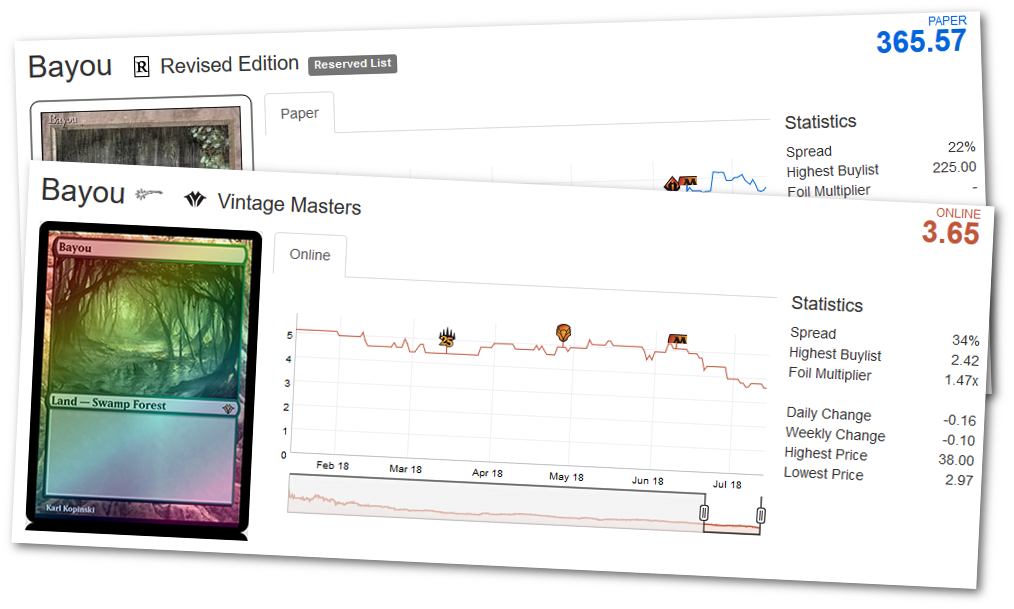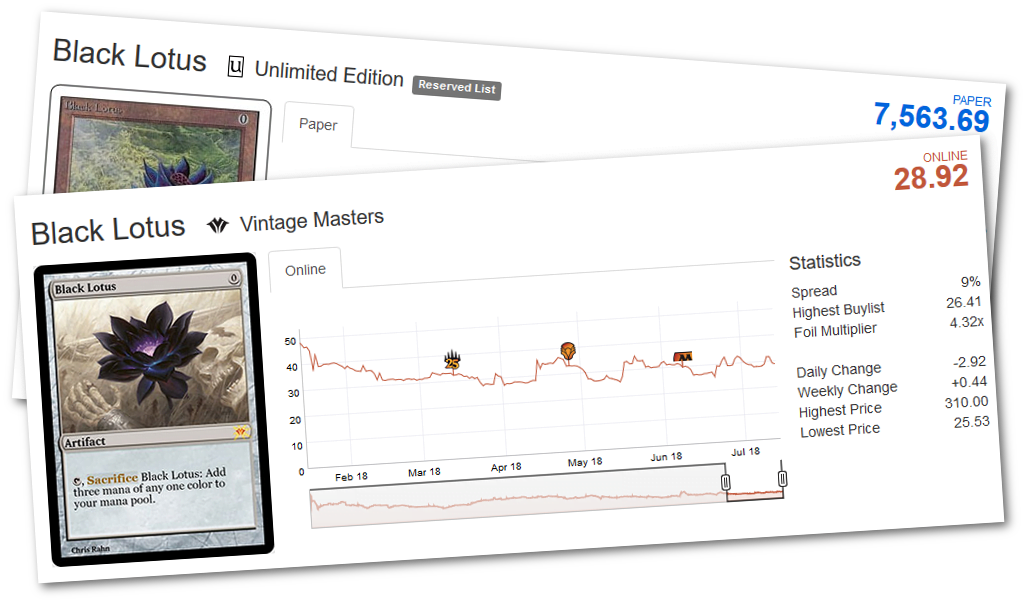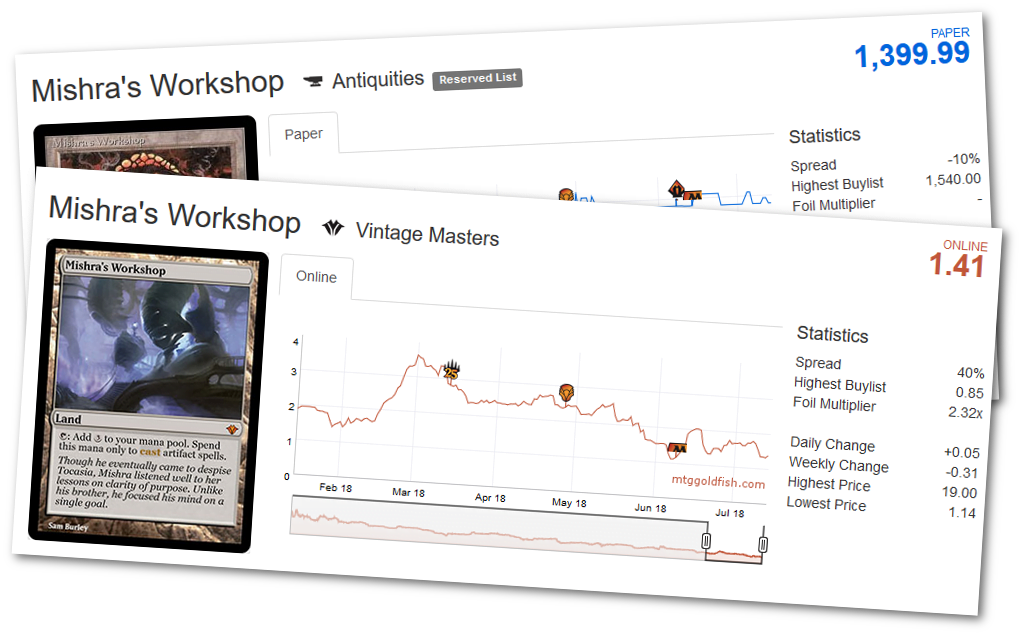I talk about materiality of games, and I’ve talked about how Magic: The Gathering has this invisible materiality that impacts how the games get designed. Now in some cases, this materiality is things like deck size and tournament duration and things that keep players shuffling and interacting with the material object. I’ve said that Commander, the format is transformed in terms of speed if you simply ban every single card that says ‘search’ and ‘library,’ or roughly 600 cards. No land-out-of-library based ramp, no more tutors, no more repetitive gamestates.
There is, however, another type of materiality that Magic: The Gathering tries to make invisible, and that’s cost.
Magic isn’t, despite what you may hear, an actually expensive hobby. It can be – you can spend a lot, but to play the game itself has a lot of really cheap venues. Digital versions of the game can be played at the highest level of access for literally nothing, for example, and then there’s MTGO, where cards’ values are largely deflated, so if you want to play (for example) a deck with Bayous, there’s a marked price difference:
 Image showing Paper Bayous for $365.57 vs MTGO Bayous for $3.65
Image showing Paper Bayous for $365.57 vs MTGO Bayous for $3.65
Cards on the table, I’m going to talk about a barrier to entry for two formats I don’t really play, and where I don’t share the same enthusiasm for those formats’… let’s say quirks as do their advocates. Basically, I know I don’t like these formats much, but that disdain for these formats’ worst elements is not part of this article. I think that Vintage is a very silly format, and I think Legacy is only slightly less silly, but this silliness shouldn’t really matter to this conversation. I play Commander, which is a very, very silly format, after all, should I act better than these other formats?
Do I think that Legacy accessability is a problem? Yeah, I absolutely do, and not all of that problem is the community. Do I think Vintage is a fundamentally broken and unfixable format of fixes and patches? Absolutely! Do I think that these formats deserve better? Probably, yeah.
Am I any kind of expert on these formats?
Heck no.
So that’s the honest framing: While there’s something I care about here, while the materiality of Legacy and Vintage cards are importand and I want to talk about it, I might be totally off-base if I say something about actual decks or the value of specific cards, but it’s okay, because those aren’t important to this conversation.
The price of real-world dual lands is a barrier to entry for Legacy, and also Vintage. Dual Lands represent sometimes as much as $700 each, the every-deck-wants-it Black Lotus is thousands of dollars on its own, and there’s the five Moxen, which are each worth one to two thousand dollars. These are not small costs – they are the costs that sort of form the foundation of the format, and you can make decks without them, but every deck wants them, and any deck that doesn’t want them can be made into a better deck by including them.

Image showing Paper Black Lotuses for $7,563.69 (nice) vs MTGO Bayous for $28.92
Vintage is not, to hear tell from people who play it, in a Good Place right now. This isn’t my expertise speaking –
https://twitter.com/efropoker/status/1017843389750890496
https://twitter.com/atoglord/status/1017598358184132610
it’s just reflecting people who as I understand it, are Pretty Good on this game. Last time I felt confident talking to people about Vintage with any sass in my voice, Oskar Tan had only just recently stopped playing.
The problem is a pretty big one – there are some cards in Vintage that are so good they’re changing the way decks get played, and that means only some strategies are worth trying, and that means you wind up with a format that is wildly swingy (because it’s Vintage) and also really similar. PO vs Stax vs Workshop vs PO, goes the refrain. It’s a world where Storm isn’t good enough, because hitting ten is hard compared to just going infinite with Time Vaults or something. Again, I am no expert.
But there’s a concern when the time comes to fix this format, which is generally done by Wizards with the introduction of new elements or the removal of other elements (through restriction). It’s hard to add elements to these decks because they’re all relying on broken old cards interacting with new cards, so new cards sometimes just make things worse. It’s hard to predict those effects, and if the format is all about new things responding to old things you get the same ‘do it before they can beat you’ problem.
The problem is when you’re talking about cards with these truly ludicrous costs, restriction brings with it a really nasty side effect.

Image showing Paper Mishra’s Workshops for $1399.99 vs MTGO Bayous for $1.41
What’s more, it’s just not viable to restrict or ban Vintage into health. It’s a messed up format. It’s always going to be a messed up format, because the format is bearing too many patched-together fixes. If you restrict Mishra’s Workshop in vintage, you are going to cut its value. Maybe in half. Maybe even worse.
This is a material element of the cards that it’s hard to respect enough. In smaller formats, with smaller values, we can be a lot more hard line – hey, sorry your Rampaging Ferocidons are worth less now, they’ll still have some modern value. Those formats are just safer environments and things that aren’t useful in one have some use in other, older formats. Rampaging Ferocidon is, at least at at the moment, useful in Modern as a 3/3 menace creature that punishes life-gain, after all.
But when you’re talking about the oldest format, the only format with the really dank stuff in it, there isn’t anywhere else for a card to go. A restricted Mishra’s Workshop will still be expensive – because it’s still a limited supply thing – but it’s not like you can go to the local store, sell them for most of their value and use that money to pick up a new, different Vintage deck skeleton. It isn’t what can work at the high values and relatively low population of that market.
The basic thing is that there are only so many Vintage decks that can actually be made at a time – only N thousand duals, only Y thousand Lotuses. Then, serving those potential decks are the people who can afford Vintage decks. Then, of that population of people who can afford it, there’s a subset of people who actually want to play with their Vintage cards rather than treat them as an investment. These are not enormous numbers. They are not capable of absorbing too much weird stuff.
It’s kind of an interesting catch-22. If the most expensive cards were out of the format, you could get more people to play the format, but if you did that, the format would lose a lot of the people who were already playing it, as they were driven out by the loss of value of their deck components.
I’m not saying I know what the decision needs to be, but I will say that these decisions need to be made with different criteria than with other formats. Vintage is expensive, and will always (as we understand always) be expensive, and Vintage players are people. Expecting them to absorb losses in the same way, at the same scale, seems a bad idea. I don’t envy whoever has to make these decisions about what to restrict, but I do know this much:
Whatever the decision is, it can’t be easy.
All prices here were obtained from MTG Goldfish.com